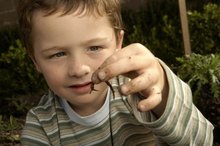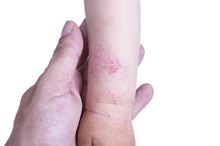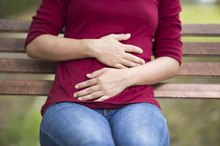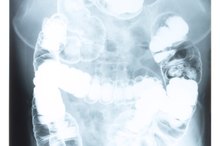Symptoms of Intestinal Worms in Children
Intestinal worms grow in children who have ingested larva eggs, typically from exposure to soil or surfaces contaminated with human feces. Three common types of intestinal worm affecting children in the United States are pinworms, tapeworms and roundworms 1. Together, they make up a group of parasites called helminths. While none of the three conditions are usually fatal, it can lead to unpleasant side effects and affect your child's health and happiness.
If you are experiencing serious medical symptoms, seek emergency treatment immediately.
Pinworm Symptoms
Pinworm affects up to 50 percent of the U.S population, frequently affecting children under the age of 18. Because worms lay eggs around the anus at night, symptoms include insomnia and waking up in an irritable mood. General itching around the anus is common 1. Female children may also experience itching in the vaginal area. Both sexes may experience spells of nausea and abdominal pain.
- Pinworm affects up to 50 percent of the U.S population, frequently affecting children under the age of 18.
- Female children may also experience itching in the vaginal area.
Tapeworm Symptoms
Reasons for Abdominal Pain With Fever in Children
Learn More
Tapeworm infection comes in two forms -- intestinal and invasive 1. Children infected with intestinal tapeworm may not display any visible symptoms for some time. However, some children will show signs similar to other intestinal worm conditions, including nausea and abdominal pain. If your child has tapeworm they may also have decreased appetite. They may start to lose weight and become weaker over time. Diarrhea is another symptom to look out for, as well as segments of worm in the stool.
- Tapeworm infection comes in two forms -- intestinal and invasive 1.
- However, some children will show signs similar to other intestinal worm conditions, including nausea and abdominal pain.
Roundworm Symptoms
The roundworm Ascaris is the least common intestinal worm affecting children in the United States 13. Larvae enter the child's intestines, and may travel through the bloodstream to the lungs. Your child may cough or become short of breath with larvae in the lungs. Larvae return to the intestines and grow into worms, causing loss of appetite and stomach pain. Children may also lose weight and strength. It is sometimes possible to see worms in the nose, mouth or stool.
- The roundworm Ascaris is the least common intestinal worm affecting children in the United States 1.
- It is sometimes possible to see worms in the nose, mouth or stool.
Related Articles
References
- American Family Physician: Common Intestinal Parasites
- Centers for Disease Control and Prevention: Parasites -- Enterobiasis
- Centers for Disease Control and Prevention: Parasites -- Ascariasis
- Kiani H, Haghighi A, Rostami A, et al. PREVALENCE, RISK FACTORS AND SYMPTOMS ASSOCIATED TO INTESTINAL PARASITE INFECTIONS AMONG PATIENTS WITH GASTROINTESTINAL DISORDERS IN NAHAVAND, WESTERN IRAN. Rev Inst Med Trop Sao Paulo. 2016;58:42. doi:10.1590/S1678-9946201658042
- Haque R. Human intestinal parasites. J Health Popul Nutr. 2007;25(4):387-91.
- Waller PJ, Bernes G, Thamsborg SM, et al. Plants as de-worming agents of livestock in the Nordic countries: historical perspective, popular beliefs and prospects for the future. Acta Vet Scand. 2001;42(1):31-44. doi:10.1186/1751-0147-42-31
- Neag MA, Mocan A, Echeverría J, et al. Berberine: Botanical Occurrence, Traditional Uses, Extraction Methods, and Relevance in Cardiovascular, Metabolic, Hepatic, and Renal Disorders. Front Pharmacol. 2018;9:557. doi:10.3389/fphar.2018.00557
- Okeniyi JA, Ogunlesi TA, Oyelami OA, Adeyemi LA. Effectiveness of dried Carica papaya seeds against human intestinal parasitosis: a pilot study. J Med Food. 2007;10(1):194-6. doi:10.1089/jmf.2005.065
- Grzybek M, Kukula-koch W, Strachecka A, et al. Evaluation of Anthelmintic Activity and Composition of Pumpkin (Cucurbita pepo L.) Seed Extracts-In Vitro and in Vivo Studies. Int J Mol Sci. 2016;17(9):1456. doi:10.3390/ijms17091456
- Ekanem AP, Brisibe EA. Effects of ethanol extract of Artemisia annua L. against monogenean parasites of Heterobranchus longifilis. Parasitol Res. 2010;106(5):1135-9. doi:10.1007/s00436-010-1787-0
- Lepczyńska M, Białkowska J, Dzika E, Piskorz-ogórek K, Korycińska J. Blastocystis: how do specific diets and human gut microbiota affect its development and pathogenicity? Eur J Clin Microbiol Infect Dis. 2017;36(9):1531-1540. doi:10.1007/s10096-017-2965-0
- Travers MA, Florent I, Kohl L, Grellier P. Probiotics for the control of parasites: an overview. J Parasitol Res. 2011;2011:610769. doi:10.1155/2011/610769
- Ekanem AP, Brisibe EA. Effects of ethanol extract of Artemisia annua L. against monogenean parasites of Heterobranchus longifilis. Parasitol Res. 2010 Apr;106(5):1135-9.
- Grzybek M, Kukula-Koch W, Strachecka A, et al. Evaluation of Anthelmintic Activity and Composition of Pumpkin (Cucurbita pepo L.) Seed Extracts—In Vitro and in Vivo Studies. Battino M, ed. International Journal of Molecular Sciences. 2016;17(9):1456.
- Imanshahidi M, Hosseinzadeh H. Pharmacological and therapeutic effects of Berberis vulgaris and its active constituent, berberine. Phytother Res. 2008 Aug;22(8):999-1012.
- Mahmoudvand H, Saedi Dezaki E, Sharififar F, Ezatpour B, Jahanbakhsh S, Fasihi Harandi M. Protoscolecidal Effect of Berberis vulgaris Root Extract and Its Main Compound, Berberine in Cystic Echinococcosis. Iran J Parasitol. 2014 Oct-Dec;9(4):503-10.
- Okeniyi JA, Ogunlesi TA, Oyelami OA, Adeyemi LA. Effectiveness of dried Carica papaya seeds against human intestinal parasitosis: a pilot study. J Med Food. 2007 Mar;10(1):194-6.
- Rouhani S, Salehi N, Kamalinejad M, Zayeri F. Efficacy of Berberis vulgaris aqueous extract on viability of Echinococcus granulosus protoscolices. J Invest Surg. 2013 Dec;26(6):347-51.
Writer Bio
Based near London, U.K., Peter Mitchell has been a journalist and copywriter for over eight years. Credits include stories for "The Guardian" and the BBC. Mitchell is an experienced player and coach for basketball and soccer teams, and has written articles on nutrition, health and fitness. He has a First Class Bachelor of Arts (Hons.) from Bristol University.








